History House Museum
History House Museum is a collection of photographic and archival records and historical objects relating to Grey District on the West Coast of New Zealand. The museum opened in the former Grey County Council Chambers in 1996, but the building was deemed unsafe in the event of an earthquake and forced to close in 2017. A new home for the collection is being sought.
.JPG.webp) History House Museum in the former Grey County Council Chambers | |

| |
| Established | 1996 |
|---|---|
| Location | 27 Gresson Street, Greymouth, New Zealand |
| Coordinates | 42°26′52″S 171°12′12″E |
| Director | Liz Burke |
| Website | www |
Origins
History House Museum was housed in the former Grey County Council Chambers at 27 Gresson Street, Greymouth.[1] The Grey County Council was formed in 1877, and built the Grey County Council Chambers in 1924. In 1989 the building was vacated when the County Council amalgamated with the boroughs of Greymouth and Runanga and the Greymouth Harbour Board to form the Grey District Council.[2]
The project to turn the empty building into a history museum was instigated by former deputy mayor Kevin Brown, Mayor of Grey Ron Hibbs, and Kevin Beams of Grey District Council. Kevin Brown recruited volunteers from the Lions, family, and local community to fit out the building and assemble a collection.[2] The museum opened in 1996, with Brown as manager.[3] When Brown was elected Mayor in 1998, volunteer Bob Naisbitt took over the running of the museum, along with assistant historian Margaret Mort.[2]
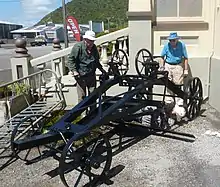
In February 2017 a seismic assessment of the Grey County Council Chambers found it was at only 10 per cent of the new building standard (NBS), well below the 34 per cent required for a public building; the standards had been revised following the 2010–2011 Christchurch earthquakes.[4] The cost to strengthen the building would be $142,000, and it is in a flood zone.[5][6] The museum was closed and the archives moved to the Grey District Library. Several options were pursued: eventually incorporating the museum into a "Discovery Centre", disbanding the collection, or moving to another space – the former Dick Smith premises at 130 Mackay Street at a cost of $50,000/year – in conjunction with an iSite visitor centre.[5]
The location of the museum (at the other end of town from the railway station where most tourists arrived) and the lack of signage were blamed for the low visitor numbers: about 6–8 people a day.[3][7] The Greymouth iSite manager Phil Barnett claimed tourists were simply not interested in its collections.[8]
In any event the Protected Objects Act and Public Records Act required the collection to be catalogued before moving, at a cost of over $100,000.[4] One consultant suggested the bulk of the collection was not "of sufficient merit" to be archived. The archives at the museum also needed to be properly stored; the Council Chambers are unsuitable and in a flood zone.[6] There is no regional archive on the West Coast, although Shantytown near Greymouth had offered to host one.[3]
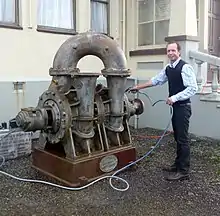
After a stocktake of the collection, items relevant to other West Coast districts were sent to the Hokitika Museum and Coaltown Museum.[9][10] The museum operated from a pop-up space in the former Dick Smith premises, operating Wednesday to Sunday afternoons from 20 December 2017.[7][11] The space had to close in July 2018 but had 1200 visitors in the first month and 9000 visitors in total, compared to the 1200 visitors a year at its former home.[12][13][14]
In September 2018, the Council budgeted $140,000 to strengthen the Gresson Street building, but resolved to move the museum to a new discovery centre combining a library and museum some time in the future.[14][15] The cost to reopen History House was estimated at $455,000, and just to make the building safe would be $170,000: even strengthened the former Council building would still have problems with climate control, fire safety, and storage.[16][17] The former manager Kevin Brown took back his extensive photograph collection in protest at the lack of progress in strengthening the building.[18] In 2020 the building was emptied and the collection moved into two climate-controlled shipping containers at a cost of $90,000.[17]
Collection
- Photographs of Greymouth, gold mining, coal mining, timber milling, shipping, living conditions and social history.
- In 1998, the Grey District Council presented the museum with a complete set of surveying instruments, believed to have belonged to engineer John Higgins, and some of the earliest may have been passed to him by Grey District's first engineer Edward Butler who died in 1884. The instruments are notable as examples of fine machining before the turn of the century.[19][20]
- A diver's suit and lead boots with oxygen wheel pump, formerly used from Greymouth Wharf.[3]
- Early coal-mining maps, donated by the Department of Commerce.[21]
- Collection displaying the region's history of greenstone jade working.[22]
In 1999, the museum held an exhibition of ten Charles Goldie reproductions, on loan from the son of the proprietor of the by-then defunct Golden Eagle Hotel.[21]
- Former displays in Grey District Council Chambers
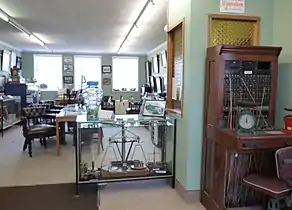 Main display room
Main display room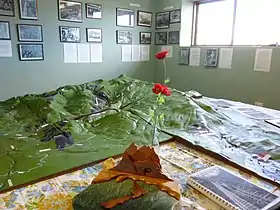 Coal mine room
Coal mine room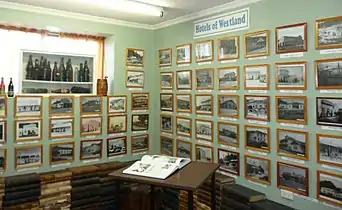 Hotels of Westland
Hotels of Westland
Publications
- Greymouth and the goldfields 1866 (1999)
- Historic Brunner, in photographs (2004)
- History of Greymouth and the area, in photographs (2004)
- West Coast ship wrecks, in photographs (2004)
- Early goldmining on the West Coast in photographs (2004)
- Historic Greymouth buildings, in photographs (2004)
- Grey area, coal mining, in photographs (2004)
- Historic Charleston, in photographs (2004)
- Greymouth 1910: celebrating 150 years since the purchase of Westland (2010)
References
- Cash, Graeme (18 October 2015). "Greymouth Floodwall Walk". Exploring My Own Backyard. Retrieved 13 September 2020.
- McBride, Paul (16 May 2009). "Recycled history". Greymouth Star. p. 7.
- Mills, Laura (6 May 2017). "Old History: the future of the Coast's museums". Greymouth Star. pp. 6–7.
- Mills, Laura (18 March 2017). "Museum decision next month". Greymouth Star. p. 1.
- McMahon, Brendon (22 March 2017). "Museum joint venture mooted". Greymouth Star. p. 1.
- McMahon, Brendon (11 August 2017). "Bulk of museum collection 'little merit'". Greymouth Star. p. 1.
- Mills, Laura (28 October 2017). "History House to reopen downtown for summer". Greymouth Star. p. 1.
- McMahon, Brendon (23 May 2017). "History House move stalls". Greymouth Star. p. 1.
- Trayes, Mary (25 October 2017). "History at a crossroads". West Coast Messenger. pp. 1–2.
- "History House thins out collection". Greymouth Star. 2 October 2018. Retrieved 13 September 2020.
- Tobin, Chris (18 December 2017). "Museum in New Home". Greymouth Star. p. 2.
- McMahon, Brendon (17 February 2018). "New museum site on cards". Greymouth Star. p. 1.
- Logie, Viv (14 July 2018). "Temporary museum mothballed". Greymouth Star. p. 1.
- McMahon, Brendon (11 September 2018). "History House moves home". Greymouth Star. p. 1.
- McMahon, Brendon (21 February 2020). "Museum-Library plan on cards". Greymouth Star. p. 1.
- McMahon, Brendon (17 August 2019). "Museum future still up in air". Greymouth Star. p. 1.
- McMahon, Brendon (10 March 2020). "History House cleared out". Greymouth Star. p. 1.
- "Old photos repossessed". Greymouth Star. 6 July 2019. p. 1.
- "Greymouth survey gear preserved". The Press. 23 December 1998.
- "Death of Mr Edward Butler". paperspast.natlib.govt.nz. Retrieved 13 September 2020.
- "Greymouth's Goldie prints for exhibition, dart holes and all". The Press. 27 May 1999.
- "Christchurch to Greymouth by Train," Great Journeys of New Zealand. Retrieved 13 September 2020.